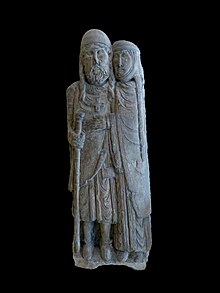Participation of women in crusades
The participation of women in crusades is a topic that has only recently been explored by research.
Women belonged to the group of non-combatants who accompanied an army of crusaders as a train (other non-combatants were: clerics, the elderly and the poor). The organizers of crusades tried to keep the number of noncombatants as low as possible; in this context it also belonged to forbid women to participate in the crusade.
Pilgrims
Carrying arms and actively participating in combat was a privilege of men in medieval society . If contemporaries understood the crusades to be armed pilgrimages , unarmed pilgrims could set off for the Holy Land accompanied by the crusaders . The role model of the pilgrim, which has been available since late antiquity, could be used for this. In addition to the fabric cross, crusaders received pilgrim staff and bags when they set off until the end of the 12th century , which shows the proximity to the concept of pilgrimage. "You migrated to the Holy Land in families, and if the father died on the way, the wife moved on with the children."
Mention in narrative sources
Noble women up to the crusader queens brought their own suite of servants ( cubiculariae ) with them on the crusade.
The lower the social status, the more incidental the mention of women in the sources. The chronicler Albert von Aachen reports on a group of crusaders who had already been killed or captured by the Seljuks in northern Anatolia . He describes the suffering of the “extremely distinguished women and excellent matrons” and adds briefly that there were also (simple) women among the dead.
Women in the entourage actively contributed to carrying out a crusade. They sewed the leather covers to protect the siege engines , they cooked for the fighters and tended to the wounded. The sources most frequently mention laundresses, a larger and apparently indispensable group of women, including old, respectable people and young women, whose presence was disapproved by some chroniclers (who upheld an ideal of abstinence). However , it is not clear from the sources whether prostitutes accompanied the crusaders.
Some noble women had the opportunity to influence the crusade itself. From bedside, for example, Margaret of Provence organized the defense of the Damiette fortress during the Sixth Crusade and obtained the release of her husband, who had been taken prisoner.
Known crusaders
- Florine of Burgundy
- Ida from Austria
- Eleanor of Aquitaine
- Berengaria of Navarre
- Joan of England
- Marie of Champagne
- Margaret of Provence
- Beatrix of Provence
- Mathilde of Brabant
- Isabella of Aragon
- Isabella of France
- Joan of Toulouse
- Eleanor of Castile
- Alix of Brittany
literature
- Sabine Geldsetzer: Women around the Crusades of the 12th century . In: Marita Krauss, Holger Sonnabend (Eds.): Women and Migration , Stuttgart 2001, ISBN 3-515-07815-0 , pp. 37-75.
- Sabine Geldsetzer: Women on Crusades, 1096–1291 . Scientific Book Society, Darmstadt 2003, ISBN 978-3-534-13736-7 .
- Susan Edgington, Sarah Lambert (Eds.): Gendering the Crusades . Columbia University Press, New York 2002, ISBN 0-231-12598-4 .
- Natasha R. Hodgson: Women, Crusading and the Holy Land in Historical Narrative . The Boydell Press, Woodbridge 2007, ISBN 978-1-84383-332-1 .
- Reinhard Barth: Women in the crusades . In: World and Environment of the Bible 29 (2003), p. 21.

